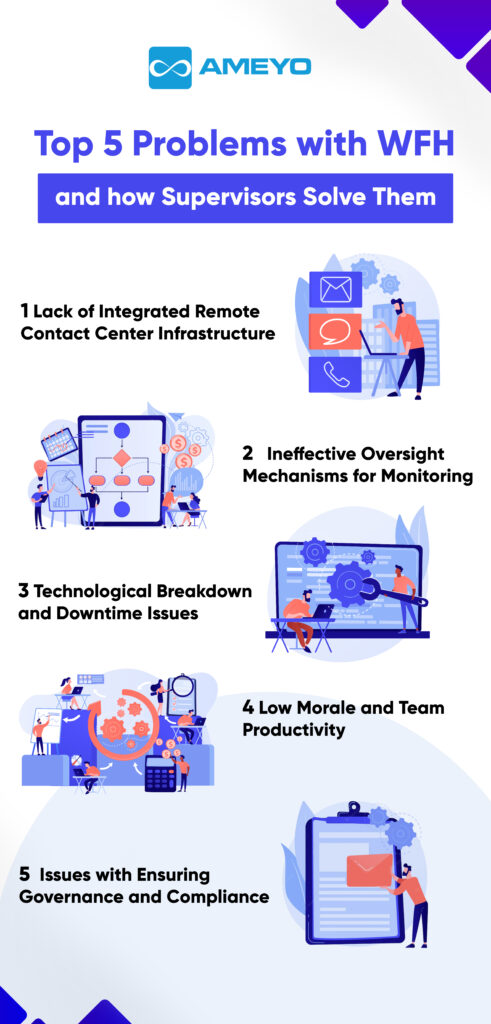Within the contact center industry, remote work is emerging as an opportunity and a challenge, with supervisors having to adjust to the new norm and adapt strategies. While just a few years ago only 6% of employees worked from home, now more than 77% of service firms are planning on enhancing work from home infrastructures long term.
The shift towards remote resource and network management is also being supported through technology integration. Firms are also retraining employees to work synchronously in a remote cloud contact center environment.
Around 75% of contact centers plan on migrating resources to the cloud to provide the right support to their remote value network
– Deloitte
With WFH (work from home) becoming the new normal for the industry, it is important to optimize all business operations. WFH offers greater productivity, lower cost, and more opportunities for contact center businesses, which is why they are investing in scalable remote technology software. In addition, with WFH giving agents and managers more flexibility, contact centers need to support the new norm with the right technology infrastructure.
Understanding Contact Center Supervisor Challenges
Contact center supervisors experience a wide range of challenges, impacting their strategic and day-to-day activities as they navigate the remote resource network. The hardware and cloud infrastructure developed will need to be transformed to ensure utility in the new work-from-home ecosystem
Additionally, supervisors can’t solve challenges dynamically if they use different online and offline software. A lack of integration of tools, assets, and resources impacts their output while introducing the risk of miscommunication and information loss. Maintaining motivation and the continuous connection is also challenging in the work-from-home environment, which can detrimentally impact supervisor-agent relationships.
The problem is also not limited to the contact center industry, with nearly 40% of supervisors across global sectors experiencing lower self-confidence in managing remote workers productively. Supervisors within the contact center industry face the additional challenge of ensuring 99% uptime, real-time scheduling, call routing management, and security & compliance control.
Top 5 Problems with WFH and how Supervisors Solve Them
By understanding the scale of the problem, we can start reviewing the leading challenges that supervisors face and how they can overcome them strategically.

1. Lack of Integrated Remote Contact Center Infrastructure
To truly offer continuous value to clients, remote contact centers need to adopt a dedicated cloud-first infrastructure. The lack of an integrated solution can lead to agent non-connectivity, inconsistent call quality, lack of information access, non-cyber security activities, etc.
The overall output of agents will decrease, leading to additional supervisory efforts, training, and monitoring. It will also be difficult to scale team culture, as solving problems at an agent level will be nearly impossible without a completely integrated cloud-based contact center solution.
2. Ineffective Oversight Mechanisms for Complete Monitoring
There is a significant issue of lack of visibility when supervisors need to manage remote networks. There can be quality issues, challenges with agent performance, call length problems, information delay, and lack of query resolution. Supervisors will not know whether call drops were caused by customers hanging up, agents disconnecting, or technology failing.
In an office space, managers can rely on traditional setups to monitor activities, but supervisors can’t physically move from one agent to another in the digital ecosystem. An AI-based call center software is the solution to this challenge, as it can standardize workflows, provide real-time reports, and automatically update status. Additionally, with key risk controls setup, auto-flagging can immediately bring issues to supervisors for quicker oversight.
3. Problems with Technology Breakdown and Downtime
This is a common problem for supervisors that need to run highly agile contact center services for clients. Traditional equipment, hardware, setups, and data warehouses will experience breakdown as they are not equipped to handle large volumes of remote traffic. With dozens of agents connecting simultaneously, there will be crashes and regular downtime.
A critical solution to this is to adopt a complete call center management solution. The right cloud-based contact center solution is less likely to break down, as supervisors can monitor resource use, application uptime, and cloud output performance. Cloud-based solutions such as chat, routing, IVR, knowledge base, etc. can also be monitored closely to ensure uptime.
4. Low Morale and Team Productivity Due to Remote Connection
Morale and productivity can take a significant hit if the right resources aren’t provided to agents at the right time. Ineffective communication methods, lack of seamless data flow, non-regular supervisor check-ups, and a lack of community, can decrease motivation and increase the workload for managers.
Technology is a true solution for the problem of morale and productivity. In fact, average hold times for inbound and outbound is decreasing nearly 53% owing to better productivity-driven through operational digitization. Supervisors can establish skill-based routing, auto-forwarding to mobiles, and 360-degree customer views, to empower all agents and outsourced agent staff in the remote network
5. Issues with Ensuring Governance and Compliance
A key problem area for contact center supervisors is ensuring governance so that agents follow the proper workflows designed to ensure a seamless flow. Traditional systems lack the tools necessary to enforce communication, information sharing, and customer engagement compliance.
Compliance with key processes can also be monitored through update tools and notifications. Automated reports can provide instant information on agent activity, performance, and quality. Implementing the right remote work policies and monthly check-ins can also significantly improve compliance with customer engagement protocols.
WFH is Here to Stay, Keep the Track
With remote work being the new norm, there are several challenges and opportunities opening for contact center businesses. Remote work is more challenging for supervisors in the contact center industry, as they rely on real-time tools to solve problems with greater agility.
In addition, ensuring KPI compliance, governance, monitoring, and technology uptime is challenging when working in a hybrid remote environment. While the challenges above are impacting the output of supervisors within the industry, the benefits made available through WFH are multi-fold.
Firms can seamlessly handle these challenges with the right technology software, corporate policies, training, and monitoring tools. The right cloud contact center software can alleviate many of the problems supervisors face daily while providing deep analytics on agent performance, call analysis, resolution rates, etc.
Transform your call center operations, with Ameyo’s remote contact center solution.

